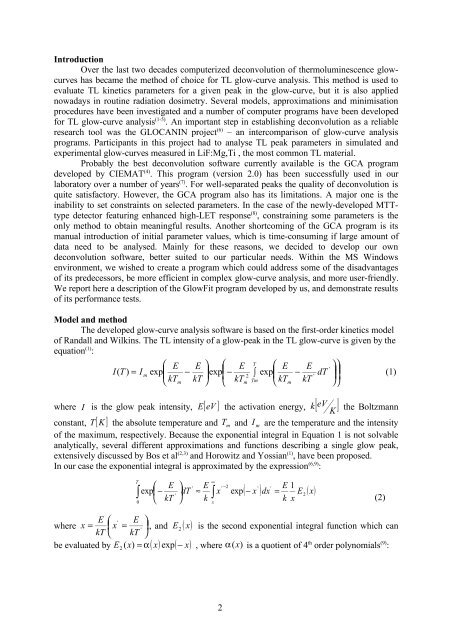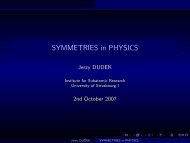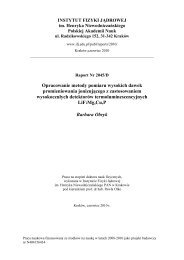GlowFit â a new tool for thermoluminescence glow curves doconvo
GlowFit â a new tool for thermoluminescence glow curves doconvo
GlowFit â a new tool for thermoluminescence glow curves doconvo
You also want an ePaper? Increase the reach of your titles
YUMPU automatically turns print PDFs into web optimized ePapers that Google loves.
Introduction<br />
Over the last two decades computerized deconvolution of <strong>thermoluminescence</strong> <strong>glow</strong><strong>curves</strong><br />
has became the method of choice <strong>for</strong> TL <strong>glow</strong>-curve analysis. This method is used to<br />
evaluate TL kinetics parameters <strong>for</strong> a given peak in the <strong>glow</strong>-curve, but it is also applied<br />
nowadays in routine radiation dosimetry. Several models, approximations and minimisation<br />
procedures have been investigated and a number of computer programs have been developed<br />
<strong>for</strong> TL <strong>glow</strong>-curve analysis (1-5) . An important step in establishing deconvolution as a reliable<br />
research <strong>tool</strong> was the GLOCANIN project (6) – an intercomparison of <strong>glow</strong>-curve analysis<br />
programs. Participants in this project had to analyse TL peak parameters in simulated and<br />
experimental <strong>glow</strong>-<strong>curves</strong> measured in LiF:Mg,Ti , the most common TL material.<br />
Probably the best deconvolution software currently available is the GCA program<br />
developed by CIEMAT (4) . This program (version 2.0) has been successfully used in our<br />
laboratory over a number of years (7) . For well-separated peaks the quality of deconvolution is<br />
quite satisfactory. However, the GCA program also has its limitations. A major one is the<br />
inability to set constraints on selected parameters. In the case of the <strong>new</strong>ly-developed MTTtype<br />
detector featuring enhanced high-LET response (8) , constraining some parameters is the<br />
only method to obtain meaningful results. Another shortcoming of the GCA program is its<br />
manual introduction of initial parameter values, which is time-consuming if large amount of<br />
data need to be analysed. Mainly <strong>for</strong> these reasons, we decided to develop our own<br />
deconvolution software, better suited to our particular needs. Within the MS Windows<br />
environment, we wished to create a program which could address some of the disadvantages<br />
of its predecessors, be more efficient in complex <strong>glow</strong>-curve analysis, and more user-friendly.<br />
We report here a description of the <strong>GlowFit</strong> program developed by us, and demonstrate results<br />
of its per<strong>for</strong>mance tests.<br />
Model and method<br />
The developed <strong>glow</strong>-curve analysis software is based on the first-order kinetics model<br />
of Randall and Wilkins. The TL intensity of a <strong>glow</strong>-peak in the TL <strong>glow</strong>-curve is given by the<br />
equation (1) :<br />
I(<br />
T ) = I<br />
⎛<br />
exp<br />
⎜<br />
⎝<br />
where I is the <strong>glow</strong> peak intensity, [ eV ]<br />
constant, [ K ]<br />
m<br />
E<br />
kT<br />
m<br />
−<br />
E<br />
kT<br />
⎞ ⎛<br />
T<br />
⎜<br />
E ⎛<br />
⎟exp<br />
− ∫ exp<br />
⎜<br />
2<br />
⎠<br />
Tm<br />
⎝ kTm<br />
⎝<br />
E<br />
−<br />
kT<br />
E the activation energy, [ eV ]<br />
k<br />
K<br />
the Boltzmann<br />
T the absolute temperature and T<br />
m and I<br />
m are the temperature and the intensity<br />
of the maximum, respectively. Because the exponential integral in Equation 1 is not solvable<br />
analytically, several different approximations and functions describing a single <strong>glow</strong> peak,<br />
extensively discussed by Bos et al (2,3) and Horowitz and Yossian (1) , have been proposed.<br />
In our case the exponential integral is approximated by the expression (6,9) :<br />
E<br />
kT<br />
m<br />
'<br />
⎞<br />
⎟<br />
⎟ ⎞<br />
'<br />
dT<br />
⎠⎠<br />
(1)<br />
T<br />
∫<br />
0<br />
' ' E 1<br />
( − x ) dx E ( x)<br />
∞<br />
⎛ E ⎞ ' E ' −2<br />
exp ⎜ − dT ≈ x exp =<br />
'<br />
⎟<br />
⎝ kT ⎠ k<br />
∫<br />
k<br />
x<br />
x<br />
2<br />
(2)<br />
where<br />
E ⎛ ' E ⎞<br />
⎜ x = ⎟ E x<br />
kT ⎝ kT<br />
2 is the second exponential integral function which can<br />
⎠<br />
E2 ( x)<br />
= α x exp − x , where α (x)<br />
is a quotient of 4 th order polynomials (9) :<br />
x , and ( )<br />
=<br />
'<br />
be evaluated by ( ) ( )<br />
2
















